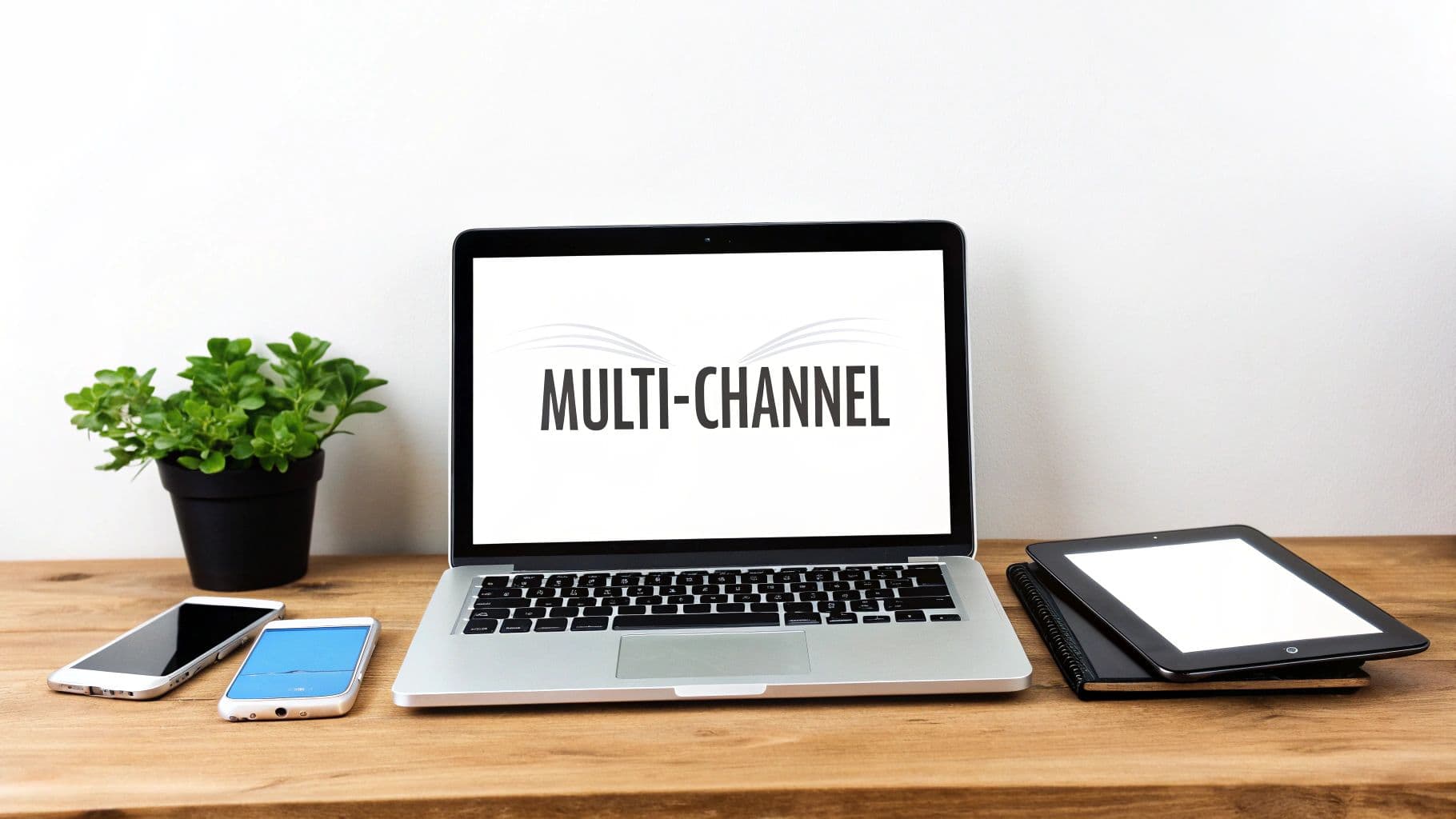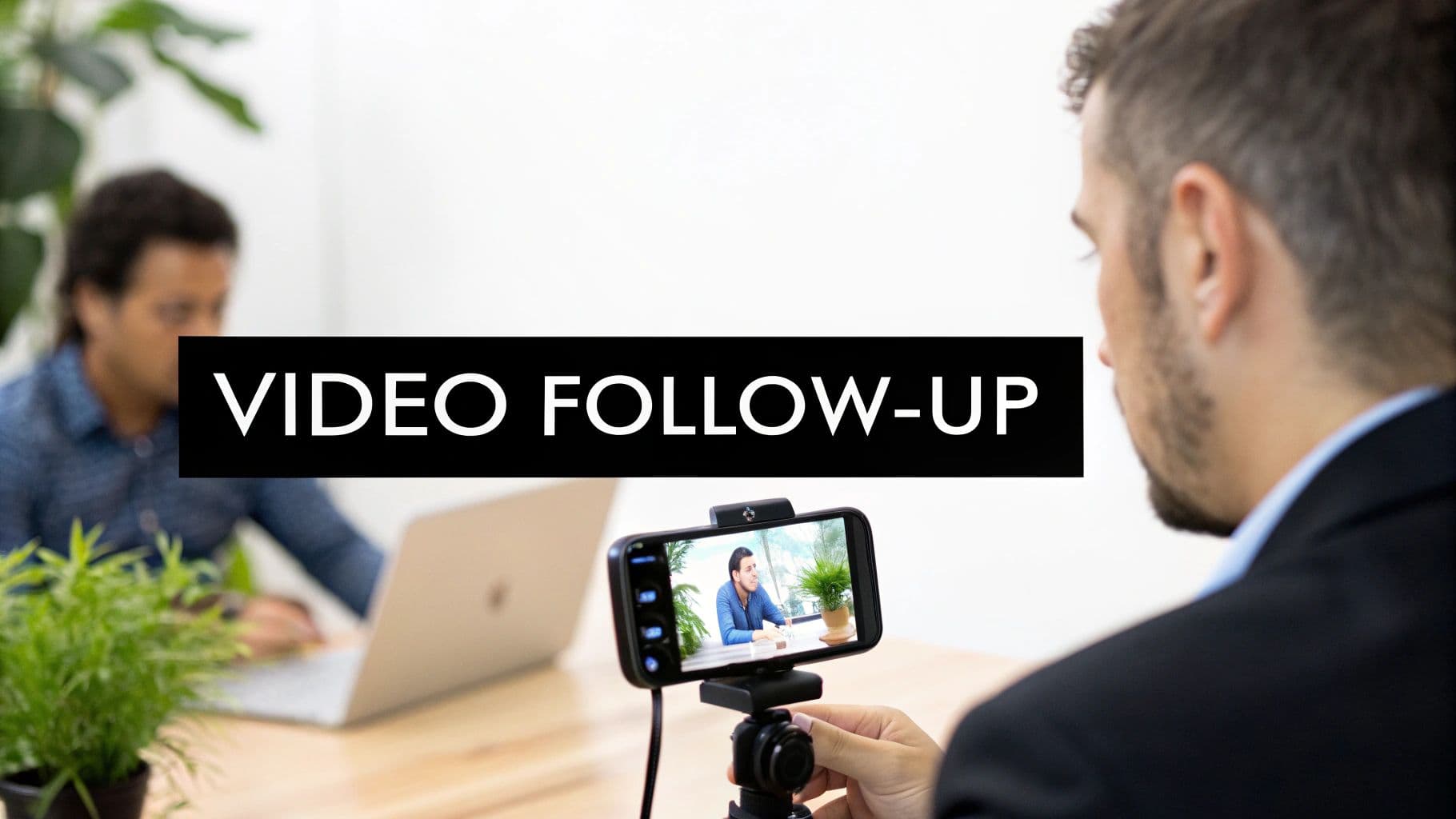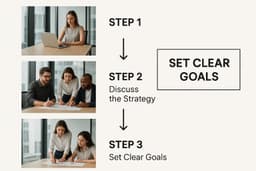You've had a great meeting. The conversation flowed, key points were made, and action items were assigned. But what happens next? The difference between a stalled deal and a signed contract often lies in the quality and persistence of your follow-up. Generic "just checking in" emails no longer cut it. To truly move the needle, you need a structured, value-driven approach that leverages insights from every interaction.
Modern meeting summarization tools are excellent at capturing what was said, but their true power is unlocked when those notes become catalysts for action. This guide breaks down 10 effective follow up strategies designed for that exact purpose. We will cover a range of actionable techniques, from multi-channel sequences and personalized video messages to pain point-based triggers. Each strategy is designed to help you engage prospects meaningfully, stay top-of-mind, and accelerate your sales cycle without feeling pushy.
These methods are applicable across various industries. For a comprehensive guide on optimizing your lead engagement, particularly in a specialized sector, you can read about franchise lead follow-up best practices to see how these principles are applied. The following list provides a clear roadmap for turning post-meeting momentum into tangible results.
1. Multi-Channel Follow-Up
Relying solely on email for follow-ups is like fishing with a single hook; you might get a bite, but you’re missing a sea of opportunities. A multi-channel follow-up strategy diversifies your approach, using various communication platforms to connect with prospects where they are most active. This method significantly boosts your chances of engagement by acknowledging that different people prefer different ways of communicating, from a quick SMS to a formal LinkedIn message.

This is one of the most effective follow up strategies because it prevents you from being ignored in a crowded inbox. Platforms like HubSpot and Salesforce champion this approach by integrating email sequences, phone call reminders, and social media outreach into a single, cohesive workflow. The goal isn’t to overwhelm prospects but to create persistent, polite touchpoints across their digital landscape.
How to Implement This Strategy
To get started, map out a sequence that logically progresses from one channel to another. Maintain consistent messaging but tailor the tone for each platform.
- Day 1: Send a detailed follow-up email summarizing your meeting.
- Day 3: Connect with them on LinkedIn with a brief, personalized note referencing your email.
- Day 5: Make a phone call to discuss any immediate questions they might have.
- Day 7: Send a final, concise email or even a text message if you have prior permission.
This structured cadence ensures your follow-up is organized and respectful of the prospect's time, making your outreach feel helpful rather than intrusive. By tracking engagement on each channel, you can refine your approach based on what works best for your audience.
2. The 5-Touch Follow-Up Rule
Giving up after one or two attempts is a common mistake that leaves significant opportunities on the table. The 5-Touch Follow-Up Rule provides a structured framework that standardizes persistence, establishing a sequence of five contact attempts before you close the loop. Research consistently shows that most sales conversions happen after the fifth touch, making this one of the most effective follow up strategies for balancing persistence with respect for the prospect's time.

This method provides a clear roadmap, preventing you from seeming disorganized or overly aggressive. Many high-performing tech sales teams and traditional industries like real estate and insurance use variations of this model as a baseline for their outreach cadences. The core principle is simple: each touchpoint is a new opportunity to provide value and build a relationship, not just to ask for a sale.
How to Implement This Strategy
To execute this strategy, create a cadence that varies the communication channel and the value you provide. Space each touch 2-5 days apart to maintain momentum without overwhelming your contact.
- Touch 1: Send an initial follow-up email with the meeting summary and key takeaways.
- Touch 2: Connect on LinkedIn with a personalized note referencing your conversation.
- Touch 3: Make a brief phone call to address any quick questions and offer assistance.
- Touch 4: Share a relevant resource, like a case study or blog post, that addresses a pain point they mentioned.
- Touch 5: Send a final, polite "break-up" email to close the loop gracefully, leaving the door open for future contact.
This organized approach ensures you cover your bases thoroughly and professionally. By documenting the outcome after the fifth touch in your CRM, you maintain a clean pipeline and gather data to refine future outreach.
3. Personalized Value-Add Follow-Up
Pushing for a decision without offering anything in return can make your follow-up feel transactional and unwelcome. A personalized value-add approach transforms your outreach from a simple check-in to a genuinely helpful interaction. This strategy involves researching the prospect’s specific challenges and industry landscape to provide tailored resources, insights, or solutions that address their immediate pain points, positioning you as a trusted advisor.
This is one of the most effective follow up strategies because it demonstrates genuine interest and builds rapport. Instead of asking for something, you’re giving something. Thought leaders like Jeb Blount have popularized this consultative approach, which shifts the dynamic from a sales pitch to a partnership. The goal is to make every touchpoint so valuable that the prospect looks forward to hearing from you.
How to Implement This Strategy
To begin, use your initial meeting notes to identify specific needs and pain points. You can learn more about how to take better meeting notes to capture these crucial details effectively. Then, research relevant industry trends or company news to find opportunities to add value.
- Share a Relevant Article: Find a recent article or industry report that speaks directly to a challenge they mentioned. Add a personal note explaining why you thought it would be helpful.
- Provide a Case Study: Send a case study of a similar company in their industry that overcame a comparable problem.
- Offer a Custom Resource: Create a small, customized resource, like a checklist or a brief analysis, that addresses their unique situation.
- Introduce a Connection: If appropriate, offer to connect them with someone in your network who could provide additional insight or support.
This method requires more effort than a generic follow-up, but it proves you are invested in their success, not just in closing a deal. This thoughtful persistence builds strong, lasting business relationships.
4. Automated Email Sequences with Delay Logic
Manually tracking every single follow-up is an inefficient use of valuable time. Automated email sequences with delay logic act as your personal sales assistant, sending pre-planned messages at the right moments without you lifting a finger. This approach uses conditional triggers based on prospect behavior, such as opening an email or clicking a link, to deliver relevant content and keep the conversation moving forward.
This is one of the most effective follow up strategies because it scales your outreach while maintaining a personalized touch. Platforms like HubSpot, Mailchimp, and ActiveCampaign allow you to build sophisticated workflows that adapt to each prospect’s engagement level. A lead who clicks on a pricing page link, for example, can be automatically moved into a different sequence than one who hasn't opened your first three emails.
How to Implement This Strategy
Start by outlining a clear goal for your sequence, whether it's booking a demo or sharing a case study. Build your workflow around key decision points, using prospect actions to guide the next step. Learn more about how to streamline these processes with meeting automation tools.
- Initial Email: Send your primary follow-up message with a clear call-to-action.
- Conditional Split: If the prospect clicks a link, send them a targeted email with more information. If they don’t open it within 3 days, send a friendly reminder with a different subject line.
- Behavioral Triggers: Use actions like visiting your website or downloading a resource to trigger a new, more specific sequence.
- Sequence End: Keep sequences to 3-7 emails maximum to avoid fatigue and always include a clear unsubscribe link.
This intelligent approach ensures you’re only engaging with interested prospects, which improves deliverability and focuses your manual efforts where they matter most. By testing different triggers and messaging, you can create a powerful, self-optimizing follow-up machine.
5. The Voicemail Follow-Up Strategy
In an era dominated by digital noise, a well-crafted voicemail can cut through the clutter and make a memorable impression. The Voicemail Follow-Up Strategy leverages brief, personal, and compelling audio messages to stand out in a sea of unread emails. This approach recognizes that the human voice conveys tone and sincerity in a way that text cannot, differentiating your outreach and prompting a direct response.
This is one of the most effective follow up strategies for adding a personal touch to an automated cadence. It’s particularly powerful in industries like enterprise sales, financial services, and recruitment, where building rapport is critical. Sales experts like Jeb Blount have long advocated for this method, emphasizing that a strategic voicemail is not a failed call but a planned touchpoint designed to build familiarity and intrigue.
How to Implement This Strategy
The key to a successful voicemail is to be concise, confident, and clear. Your message should sound natural, not like a pre-written script.
- Keep it under 30 seconds. State your name, company, and the reason for your call quickly.
- Reference previous contact. Mention a prior email or meeting to provide context.
- Offer value, not a sales pitch. Briefly mention a specific insight or solution relevant to them.
- Leave your callback number twice. Say it clearly at the beginning and end of the message.
- Call at strategic times. Aim for early morning, lunchtime, or late afternoon when prospects are less likely to answer but will check messages.
This disciplined approach ensures your voicemail is perceived as a professional and thoughtful communication, increasing the likelihood of a callback and moving the conversation forward.
6. Social Proof and Referral-Based Follow-Up
Following up with a generic "just checking in" message rarely inspires action. Instead, a social proof and referral-based strategy builds instant credibility by demonstrating your value through the success of others. This approach leverages case studies, testimonials, and mutual connections to prove that your solution delivers real-world results, transforming a cold follow-up into a warm, evidence-backed conversation.
This is one of the most effective follow up strategies because it shifts the focus from what you say you can do to what you have proven you can do. Companies like Amazon AWS and Slack master this by weaving customer success stories into their sales process, making it easier for prospects to visualize their own success. The goal is to build trust and overcome skepticism by showing that similar companies have already achieved their desired outcomes with your help.
How to Implement This Strategy
Start by building a library of your success stories and identifying opportunities for warm introductions. Your follow-up should be less about reminding them of your existence and more about showing them a clear path to success.
- Initial Follow-Up: Send an email that includes a link to a case study from a company in their industry.
- Second Touchpoint: Share a short video testimonial or a powerful quote from a happy customer.
- Third Touchpoint: Ask a mutual connection for a warm introduction or mention a shared contact’s positive experience.
- Final Nudge: Offer to connect them directly with a current customer who can speak to the results they’ve seen firsthand.
This method reassures prospects that they are making a safe, well-vetted decision. By integrating social proof, your follow-up feels less like a sales pitch and more like a valuable, relevant insight that helps them solve their problems.
7. The Time-Delay Graduated Follow-Up
Not all follow-ups should carry the same weight. The Time-Delay Graduated Follow-Up is a strategic approach that methodically increases the intensity of your outreach over time. Instead of bombarding a prospect from day one, you begin with lighter, less frequent touches and gradually escalate to more direct communication, creating a sense of natural, building urgency.
This is one of the most effective follow up strategies because it respects the prospect's time while demonstrating persistent, increasing value. For example, enterprise software sales teams often use this to nurture high-value leads, starting with simple emails and escalating to personalized video messages or executive-level introductions. This method prevents premature burnout and aligns your effort with the prospect's growing engagement.
How to Implement This Strategy
To execute this, you must map out a multi-week sequence where each step introduces a higher-value touchpoint. The key is to increase personalization and directness with each interaction.
- Week 1: Send a simple, friendly email checking in.
- Week 2: Follow up with another light email, perhaps sharing a relevant article or case study.
- Week 3: Place a brief, no-pressure phone call to offer direct assistance.
- Week 4: Send a personalized video message addressing their specific needs or pain points.
- Week 5: Propose a high-value offer, such as a custom demo, a strategic consultation, or an invitation to an exclusive event.
This graduated cadence ensures your follow-up feels thoughtful and tailored, not automated. By tracking which stage elicits a response, you can optimize your sequence for different types of prospects.
8. Video Message Follow-Up
Text-based emails can easily get lost in a crowded inbox, but a personalized video message stands out immediately. This strategy involves sending a short, custom video to a prospect, combining the warmth of a face-to-face conversation with the convenience of a digital message. It adds a human touch that text alone cannot convey, making your follow-up memorable and significantly boosting engagement rates.

This is one of the most effective follow up strategies for building a genuine connection quickly. Tools like Loom and HubSpot’s native video feature make it simple to record and share these messages directly within an email. The goal is to create a personal touchpoint that shows you’ve invested extra effort, referencing specific details from your previous conversation to demonstrate you were listening.
How to Implement This Strategy
To create an impactful video follow-up, focus on being authentic and providing value. Keep it brief and professional, ensuring your message is clear and your call-to-action is easy to follow.
- Keep it short: Aim for 30-60 seconds to respect your prospect's time and maintain their attention.
- Personalize your message: Start by addressing them by name and reference a specific point from your last meeting.
- Show, don’t just tell: Use screen sharing to quickly walk through a relevant part of your platform or highlight a key data point.
- Maintain eye contact: Look directly at the camera to create a stronger, more personal connection.
- End with a clear CTA: Conclude by clearly stating the next step, such as, "Click the link below to book a 15-minute call."
9. LinkedIn-Based Follow-Up Strategy
In the professional world, LinkedIn is far more than a digital resume; it's a powerful arena for building relationships and executing nuanced follow-ups. A LinkedIn-based follow-up strategy leverages the platform's features to stay top-of-mind with prospects in a context where they are already focused on business. It’s a subtle yet effective way to demonstrate your expertise and maintain a professional connection without flooding their email inbox.
This is one of the most effective follow up strategies for B2B sales because it builds credibility and rapport over time. Instead of a cold outreach, you engage with their content, share relevant insights, and establish yourself as a valuable resource within their network. Tools like LinkedIn Sales Navigator are specifically designed to facilitate this process, allowing you to track leads and identify opportunities for meaningful interaction, turning a simple connection into a warm conversation.
How to Implement This Strategy
A successful LinkedIn follow-up is about strategic engagement, not just sending messages. The goal is to build visibility and trust before making another direct ask.
- Day 1: Send a personalized connection request referencing your initial meeting or conversation.
- Day 3: Once connected, engage with their recent post or a piece of content their company shared. A simple, thoughtful comment can go a long way.
- Day 5: Share an article or resource you think would be valuable to them via a direct message, tying it back to your previous discussion.
- Day 7: If you see continued engagement, transition the conversation back to email or a phone call to discuss the next steps.


